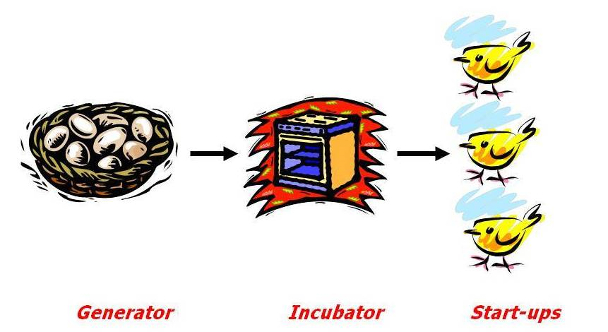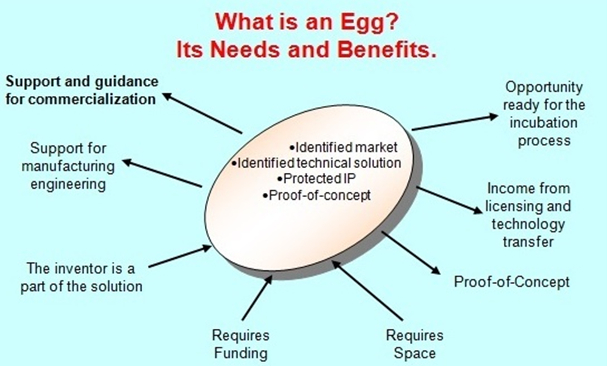Advanced Technology Generator (ATG)
The Generation Process
I had been fine-tuning the incubator concept during my entire forty-five year career. I knew that farm incubators take eggs and turn them into chickens. I looked for an analogy between start-up incubators and chicken incubators. From the physical perspective, both types of incubators are basically structures with controlled lighting, temperature, and humidity; to successfully use the farm incubators, the main ingredient one needs are eggs. I realized that these "eggs," or their equivalent in the start-up environment, were missing from the academic world's vision of the start-up incubation process.
The more I thought about this analogy, I realized just how apt it was. Start-up companies burn through a lot of their initial investors' capital just building their "barn." They rent a larger-than-necessary space, initially hire too many people, and attempt to analyze and understand their target market. All too soon, both time and money run out. In my opinion, the majority of companies that start in the incubator environment do not possess a sufficient "egg" to incubate in order to make a "chicken" (a successful company). In fact, the "egg" itself should be a prerequisite to a start-up incubation process. I concluded that a start-up company entering an incubator needs to own a viable "egg." As a result, a Generator of good "eggs" is necessary so that only viable "eggs" ready to be hatched will be transferred to a start-up that enters into the incubation process.

The generation process.
The secret ingredient in the analogy, of course, is the "egg." There are three important variables that impact and define the "egg:" (1) the intellectual property itself; (2) the knowledge of large potential markets for the resultant product; and (3) the proofs of concept that ensure that the technology works. The term "egg" was chosen because it represents a concept–technology that has yet to be incubated to reach its identity and potential, yet it has all the necessary "genetic material" to succeed.

The "egg" concept.
A more complete version explaining the concepts and ideas behind ATG is available in "My Life on the Mysterious Island of Nanotechnology" by Zvi Yaniv, available on Amazon.
The NanoBubbling "egg"
The first "egg" of ATG is dedicated to using oxygen and carbon dioxide nanobubbles for treating peripheral neuropathy. The optimized nanobubbler and the instrument to deliver the nanobubbles (patent pending) to affected areas was put in practice and is in the process of blind testing at four podiastrist offices in Austin, Texas. For more information please visit: www.nanobubbling.com
The Painting Piano "egg"
Today, almost any musical instrument is digital (for example, a keyboard, a piano, etc.). When you press a key on a digital keyboard, for example, the command creates a particular sound that can be heard. The novelty of the "painting piano" is that instead of hearing a sound the same key can be programed to create on the screen a particular element of a painting. This type of operation can be extended to all the keys such that a "painting piano player," with additional software and logic, can play the instrument to create a painting on the screen. Obviously the painting so created can be erased or can be changed until the correct image that the "painter" had in his mind is generated on the screen. Then, the resulting art work can be electronically saved, transmitted, or printed in full color.
My purpose for inventing the "painting piano" was to allow users to "paint" in the style of a chosen artist. In addition to the "painting piano" as described above, the embodiment of the concept is possible by having a "Painting Book" similar to a "Music Book" that can be played on a digital instrument such as a keyboard piano. The "Painting Book" allows the "player" to utilize the keyboard to "paint" in a specific style of a known artist of choice. The user can select from a library of music books (software) of a specific artist style similar to the "Music Book" that is dedicated to a specific composer. Therefore the main product of the invention will be the supply of the "Painting Book" customized for the chosen style of known artists.
For the proof of concept I chose the style of a known Israeli artist Jacob Agam because I like his works and I have a number of them displayed in my house. Using a very low cost keyboard with USB connection I could "paint" in the Jacob Agam style (http://www.artnet.com/artists/yaacov-agam/).
What I am looking for:
1. I am looking for a software company that wants to work with me in partnership to improve the current software that was done by amateurs and have a solid proof of concept to be shown to many computer games and brain-development companies that I believe are the main markets for this product.
2. I need support for continuous generation of "Painting Books" for different famous artists. This work will be done by young art majors that will basically decompose the artwork of a certain famous painter into components that will allow the user to paint in the desired style. Obviously, these "Painting Books" will be a serial software product so all of us can make money.
3. I need an organization that will help me with customer support.
The AquaCalor "egg"
HEAT PUMPS – ADVANTAGES & DISADVANTAGES
Heat pumps are getting more and more popular in moderate climate zones. Heat pumps offer an energy-efficient alternative to furnaces and air conditioners. Because heat pump move heat, rather than generate heat, heat pumps can provide equivalent space conditioning at a much lower cost than operating conventional heating or cooling appliances. When heat pump is working in a cooling mode, it works the same, as air conditioning system. Common disadvantage is, that during a cooling cycle, system generates a lot of heat, which currently just dissipates in the surrounding air, contributing to the global warming and wastes a lot of energy, consumed to generate such a heat. When heat pump is working in the heating mode, it moves heat from the outdoors to warm the house. Problem is, that heat pump takes heat from surrounding air and when air temperature drops, the heat pump efficiency drops as well. When outdoor temperature approaches +30F (0C), heat pump stop working and conventional heat generator needs to be operating to provide warm air.
AQUACALOR SOLUTION
The obvious solution to improve described above disadvantages, is to use similar technology, what used in the geothermal heat pumps, but for the fraction of cost. The addition of water to refrigerant heat exchanger to the refrigerant line, when external water source is available, can significantly improve heat pump operation. Most common external water source, available in many households, is a pool. Pool water energy addition to the refrigerant cooling/heating circuit, will improve heat pump efficiency by the nature of better efficiency of liquid heat exchangers, then air. In the cooling cycle, heat pump refrigerant can transfer heat to the pool water, to warm it up and extent swimming season. In the heating cycle, pool water could be used to warm cold refrigerant, when air temperature is low or close to the frizzing point, but pool water stays warm by the water volume. Pool water usually accumulates heat during daytime even in winter and can lasts though the night as a heat source for building warming.
AQUACALOR TECHNOLOGY BENEFITS
AquaCallor offers technology to modify new or existing heat pumps for households with the pool, providing follow benefits:
1 Improves heat pump efficiency.
2 Saves more then 30% on utility bills cutting energy consumption, especially in wintertime.
3 Extends the swimming season, warming pool water from usually wasted energy. With the proposed system pool heats virtually for free, without any additional investment.
4 Contributes to the climate change prevention, by minimizing wasted heat dissipation in summer and use of conventional gas or electric heaters in winter.
AQUACALOR SYSTEM COMPONENTS
1. Heat pump.
2. Heat exchanger.
3. Simple modification connecting heat exchanger to the refrigerant line
4. Pool to heat exchanger connecting pipes
5. ACS - Automatic Control System
6. Water flow direction valve
7. Valve actuator
Please see pictures below.
If no pools are available, this system could be used to heat water for household use in the summer time.